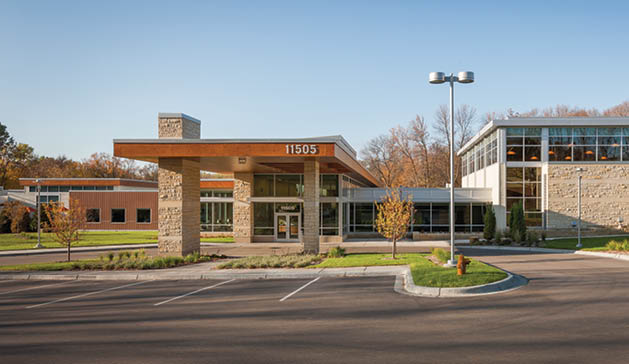Hazelden is one of the nation’s biggest names in rehabilitation, with addiction treatment centers spanning the country from California to New York. At its Plymouth location, Hazelden’s signature 12-step approach is adapted for the teen and young adult population. The facility also offers comprehensive support for parents and siblings through its Family Program, and post-treatment counseling through the Hazelden Connection program.
While a majority of patients in the 13 to 24 age range seek treatment for marijuana and alcohol addiction, there has been a marked increase in prescription pill and heroin abuse in recent years, according to Jen Stowe, a Hazelden Connection recovery coach. “Opiates are definitely on the rise,” she says. For Sarah D., a 23-year-old Hazelden alumna, the struggle with substance abuse followed a course that is now all too familiar to Stowe and the staff at Hazelden.
“I was introduced to painkillers as a [high school] senior. I went hard on them, and things went downhill quickly from there,” Sarah says. By the time she was 19, her life was “blowing up,” she says. “My family was desperate.” In January of 2011, they checked her into Hazelden.
Sarah, who has been drug- and alcohol-free since she first entered the Plymouth facility four years ago, recalls her initial surprise. “I went in thinking [it was] the worst thing that could ever happen to me. I was expecting it to feel like going into lockdown.” It was not only the bright, welcoming design of the facility (more hotel than hospital) that struck her, but also the kindness of the staff and the exposure to other young women who had been through similar experiences.
“I never really hung out with girls, growing up. To be honest, I didn’t have a lot of friends. It was cool to be around a bunch of people who got me.”
Success Stories
Now a graduate of the University of Minnesota with a bachelor’s in marketing, Sarah says, “I know [that] if my parents had sent me anywhere else, things wouldn’t have turned out so well, and I would not have the great life that I have today.” All in all, her treatment included five months of residential, beginning with the initial 25-day stint at Plymouth. For her second extended stay, she was sent to California.
These days, such transfers are rarely necessary. Thanks to a capital campaign completed in February 2014, the Plymouth location can now accommodate more female patients in the all-female Grace unit, which doubled its bed count. Stowe says the expansion allows for “truly variable lengthås of stay, from 10 to 120 days.” She describes the renovation as “more of a total revamp,” with brand new features like an updated kitchen, music and art therapy rooms, a bookstore, additional space for family and outpatient programming, and a full workout room and a gymnasium, complete with a climbing wall. Sarah, who returned to Hazelden as a marketing intern in 2014, says the campus makeover makes a big difference: “When I was there, we had to go down to the YMCA to work out.”
Frank (23) and his sister, Tina (18), of Rochester, were treated at Plymouth’s campus a few years ago. According to their mother, Jenny (last name not being used to protect privacy), both children had subsequent relapses. Still, her appreciation for Hazelden’s quality of care is unequivocal. For her children, she believes a lack of motivation is the main barrier to a sober life. “[You can] spend a million dollars on treatment, and it would all be flushed down the toilet if the kid doesn’t want to change or get well,” she says.
“[Young people] use pot these days the way, when I was a kid, everyone drank,” Jenny observes. “The drug culture in Rochester is just huge.” In addition to the ubiquity of drug use in their social circles, she says that a genetic predisposition may have been a factor for her kids. “Addiction and alcoholism run in our family very strongly.”
Before drugs came into their lives, Jenny says her relationship with both children had been good. “I don’t think there was anything egregiously dysfunctional in our family. When they turned 15, it’s like a switch went off in their brains, and their personalities changed.” She did not, however, suspect drug use. “We chalked it up to normal teenage behavior. We were just clueless.”
With Tina, when drinking and smoking progressed to Adderall and methamphetamine abuse, the formerly happy-go-lucky teen underwent a radical transformation. Her mother recalls fits of rage and even violence. “We knew that she smoked, but I didn’t know where all this anger was coming from,” Jenny says. So she decided to call Hazelden. “The first question out of the counselor’s mouth was, ‘Has she ever tested positive for amphetamines?’ Nobody had suggested that before,” Jenny says.
Before long, these suspicions were confirmed. Jenny and her husband returned home one night to find suspect-looking granules on the computer desk, along with empty capsules and cut-off straws in Tina’s room. After an initial evaluation at Hazelden, Tina was not admitted because she refused to “fess up,” Jenny says. As Hazelden is not a locked facility, part of the intake screening process is gauging the individual’s willingness to remain there. The counselor, who suspected there was more to the story, advised Jenny to keep a close watch on her daughter and to work on getting some hard proof–a feat that is particularly difficult in the case of methamphetamine, as the drug only stays in the system for 24-48 hours.
In the months that followed, things finally came to a head when Tina was caught driving drunk. She was assigned a probation officer, who monitored her drug use. She eventually tested positive.
Jenny says that both of her children flourished at Hazelden. The mentorship program—which gave them the opportunity to take newcomers under their wing—was particularly beneficial in building their self-esteem. “Tina embraced and loved her six weeks [there]. It was like summer camp for her. She was galloping through the halls, making people laugh. Of course, she cried buckets [as well]. She signed up for every group and she worked out. [She didn’t] want any down time.” While Jenny says that her daughter was “like a new person” after her treatment, she adds that “the pull of her old life,[and] her old friends, was difficult to shake [and] her addiction pulled her back in within a month.”



(Hazelden’s front entrance, book store and music room.)
Setting Boundaries
Jenny and her husband have since pledged to cut both children off until they are able to demonstrate three months of sobriety by undergoing regular drug testing. Neither child has accepted this arrangement, opting instead to support themselves. While her insurance covered much of the cost of treatment, Jenny estimates that her out-of-pocket expenses were around $10,000. Despite this expense and her children’s subsequent relapses, Jenny’s review is resoundingly positive: “I do believe [Hazelden] is the best,” she says. “Even if both kids are still using today – it was worth it. The [Family] Program alone made it worth it.”
The four-day, intensive Family Program is free to parents or guardians, as well as siblings of current inpatients. It is devoted to understanding addiction and the well-being of the addict’s loved ones. Most important, says Stowe, is “getting their minds around Step One.” In other words, accepting the fact that they cannot control the choices that their son, daughter or sibling will make. From there, they are encouraged to “redirect their energy to the things they can control, such as their own recovery, and how they can go about taking back the reins,” says Stowe.
For Jenny and her husband, learning to set boundaries was a key takeaway from this program. “[Frank] was borderline homeless when he was first kicked out. I think he slept in his car. He bounced back home a few times.” She describes their initial boundaries as “hit-or-miss” and admits that they didn’t always agree on the best course of action. When it came to kicking Tina out, they were firmer and more united in their resolve.
While this was not an easy decision to make, it’s one she stands by. “I’m willing to bet there are thousands of teenagers in America who are abusing drugs and their parents are unwittingly helping them to keep using,” Jenny says. “Many parents would never kick their kids out of the house because they are scared to let them suffer the consequences. [But they] won’t get better until people stop enabling, and the hugest thing is that they come to the end of their resources.” According to Stowe, this stance is not only vital to the wellbeing of an addict’s family, but also to the addict’s chances for recovery. “At some point, [parents] need to step back and allow the natural and logical consequences to occur,” says Stowe.
Support for Families
The Family Program is just one of many recovery management resources that Hazelden offers to its clients and their families, who also have access to a 1-800 hotline, where they can obtain free feedback for up to six months following discharge. They also have the option of bridging their treatment by enrolling in Hazelden Connection, which provides ongoing counseling and coaching.
“They don’t just leave here,” Stowe says, and points out that most clients will step down to another level of care, such as a halfway house or extended outpatient treatment. Hazelden also helps patients research the best support networks near their homes.
The Hazelden Social website is a resource for continuing support, permitting parents who established a bond during their child’s treatment in Plymouth to keep in touch. There are also live chat rooms, where parents can make new connections with people from all over the country. Jenny says she has learned a lot by posting to the very active discussion boards.
“I’ve posted questions at three in the morning, and [gotten] a reply in 15 minutes,” she says. For the most part, she communicates with individuals in some phase of recovery, granting her a new, often enlightening perspective. “You do hear a lot of relapse stories,” she says. “Drug addiction is so insidious, because it changes how you think, how you feel. It’s not that you can’t recover; it’s that it takes time to be motivated to recover.”
Finding that motivation can be particularly difficult for teens and young adults. “For my kids, being stoners was a part of their identity; they hadn’t discovered themselves yet.” Jenny’s experience suggests that not all Hazelden success stories are recovery stories. While she remains dubious of her children’s willingness to redefine themselves in drug-free terms, she says Hazelden has succeeded by simply “showing them what sober life could be like,” and giving them the tools they would need to get there.


(The Plymouth facility’s new patio area and climbing wall; Photos courtesy of Hazelden.)









